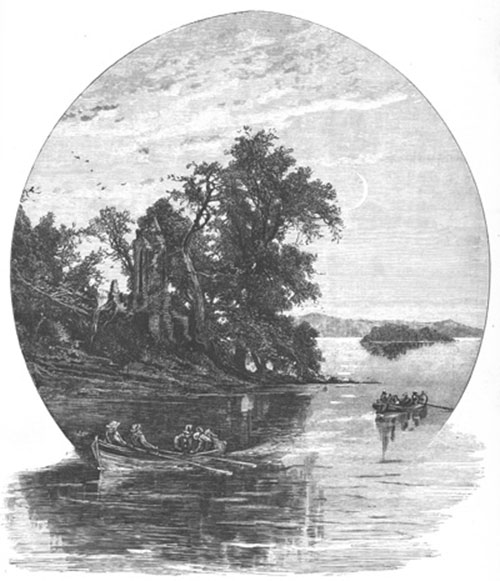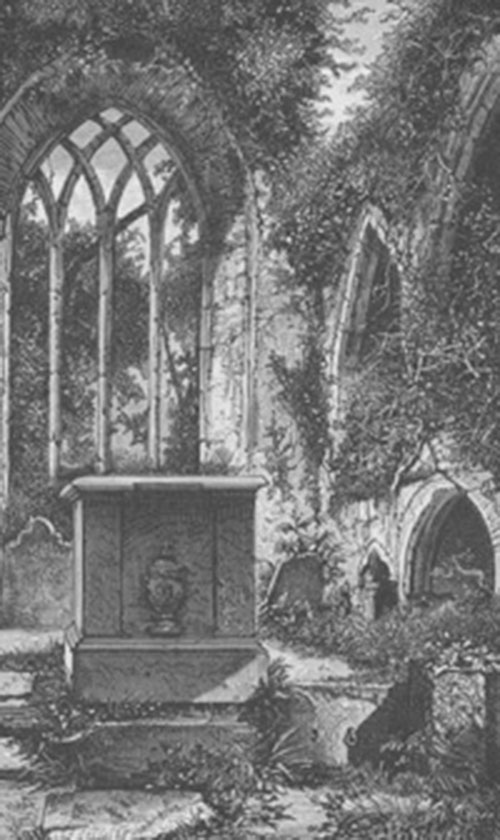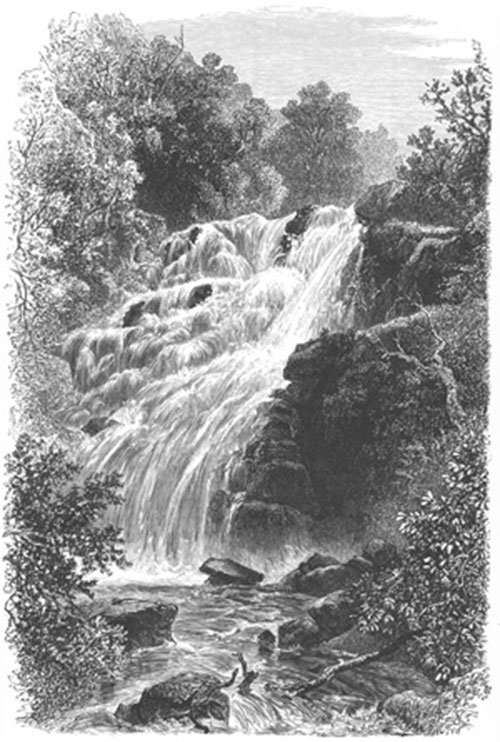Muckross Abbey - Irish Pictures (1888)
From Irish Pictures Drawn with Pen and Pencil (1888) by Richard Lovett
Chapter V: Glengariff, Killarney, and Valentia … continued
« Previous Page | Start of Chapter | Book Contents | Next Page »
After shooting the bridge, the boat glides into a most lovely part, the Meeting of the Waters, and the shore of Dinis Island, which divides the stream, one portion of the waters flowing out into the Middle or Torc Lake, the other passing on to Lough Leane.
Dinis Island is delightful, and any who have neither time nor inclination for the longer trips will find this part most accessible, and equal in beauty to any in the whole range of the Killarney lakes.
Passing under Brickeen Bridge, having tarried for a moment to gather a sprig or two of arbutus, the boat shoots out upon the wide waters of the Lower Lake. This is 5,000 acres in extent, being, roughly speaking, 5 ½ miles long by 2 ½ wide. When it is breezy, as the writer tested by experience, the waves can rise, and the rowers need to bend their backs to the oars to urge their craft across to Innisfallen and then on to Ross Island. The former, 21 acres in extent, is the gem of Lough Leane. It is lovely as regards its scenery, and it is venerable by reason of past associations. Here, in the seventh century, St. Finian founded a monastery, of which some traces have come down to us; and here one of the famous early records of Irish history, the Annals of Innisfallen, were penned. At Ross Castle we land; the engraving on page 110 enables the reader to realize what manner of ruin it is. On the mainland, opposite the Tomies' side of Innisfallen, is O'Sullivan's Cascade, which consists of three distinct falls, one of the favourite shorter excursions. At the south-eastern end of Lough Leane is the ruined Muckross Abbey. It was founded, according to Ware, by Donald MacCarthy about 1440; but the Annals of the Four Masters record that it dates from 1340; there is some evidence that the building was begun by Teige, and finished in 1440 by his son Donald. It was restored, as an inscription on the north side of the choir states, in 1626. 'The church consists of a nave and choir, separated by a belfry of small proportions, and only calculated to hold a single bell. This belfry is pierced by a narrow arch, which connects the nave and choir. On the south side of the nave there is a small chapel or transept, with which it is connected by a large archway; and on the north side a small doorway leads into the cloisters, which is the most perfect and interesting portion of the building. It is a square of twelve yards, encompassed by an arcade lighting the surrounding corridor, which is about five feet in length. The arcade consists of ten semicircular arches in its north and east sides, and twelve pointed ones on the south and west. The pillars and mouldings are of grey marble. The effect of these cloisters is rendered singularly solemn and imposing by a venerable and majestic yew-tree, which rises like a stately column from the centre of the enclosure, and which, from the density of the dark green foliage of its spreading branches, permits but a "dim, religious light" to penetrate the area. The stem of this remarkable tree, which there is no reason to doubt is coeval with the abbey, is upwards of twelve feet in height, and about six feet six inches in circumference.
'The vault of the MacCarthy Mores is placed in the centre of the choir, and is marked by a flat stone level with the floor, on which the coronet and arms of the Earl of Glencare are rudely sculptured; a more stately monument, as represented in the illustration, marks the grave of O'Donoghue of the Glens, who died in 1808, and is buried in the same vault.'[1]
Hard by Muckross Abbey the road to Mangerton, the loftiest mountain near Killarney, 2,576 feet high, turns off from the Kenmare Road. It is a very easy ascent, and the view 'is superb, embracing in the east Crohane, the Paps, Cahirbarnagh, and all that extensive country lying between Millstreet, Mallow and Tipperary, with the blue range of the Galtys in the far distance. Northward and to the west is Tralee, with the Slievemish Mountains in the neighbourhood of Dingle and Ventry, while a faint white line in the horizon marks the north estuary of the Shannon as it flows past Tarbert and Kilrush. Due west are the Torc, the Purple Mountain, and the Reeks, with Castlemaine Haven and the Laune running at their feet; to the south is an immense sea of hills occupying the district towards Kenmare. The Bays of Kenmare and Bantry are prominent objects in this view—a view which can never be blotted out from memory. At the foot lie the Lakes of Killarney in all their beauty, with the thick wood and groves encircling their shores.'[2]
At a steep part of the ascent, about three-quarters of the way up, is a depression in the mountain, from which the cliffs rise up steeply, and occupied by a tarn. This depression is known as the Devil's Punch Bowl, and from it descends one of the streams which form the Torc Waterfall. This is a fine fall, some sixty feet in height, situated in a ravine called Owengariff. It is most easily reached from Killarney by the Kenmare Road.
« Previous Page | Start of Chapter | Book Contents | Next Page »
NOTES
[1] Dublin Penny Journal, vol. i., p. 410.
[2] Murray's Handbook for Ireland, p. 317.



